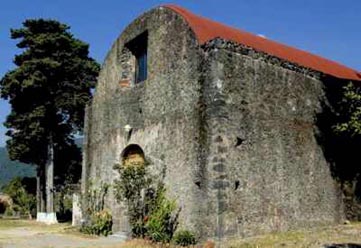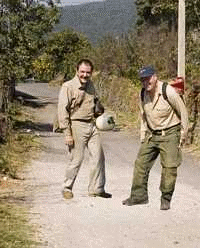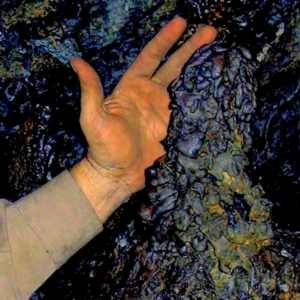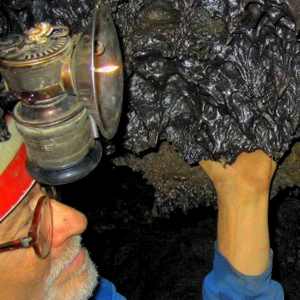 |
Trip Report
MEXICO’S MARVELOUS LAVA TUBES
Text © 2006 by John & Susy Pint - Photos © 2006 by their respective owners
Updated November, 2013
On Friday, Dec. 9, 2005, Chris Lloyd and John Pint drove from Guadalajara to Mexico City to visit some of the extraordinary lava tubes in the area. It is truly amazing that there is still no autopista directly linking the two biggest cities in the country, but we managed to get off track (we won’t say lost) only once.
It was most pleasant to exchange stories with Ramón Espinasa, Mexico’s great caving pioneer, over several beers. You may be able to sample the flavor of the stories (if not the beer) in the Interview with Ramón that accompanies this report.
Next morning we woke up Vicente Loreto by telephone and he promised he’d be right over in a half hour. Of course, we doubled that figure and soon were joined by Vicente along with “Yesica-Yasmin.” We then drove out of Mexico City toward Cuernavaca.
The Cuernavaca highway took us straight to prime cave country. “Over there,” said Ramón, who was now truly in his element, “you can see Chichinautzin Volcano which is the source of many of the lava tubes in this area. The name of this volcano means Lord that Burns which suggests that the natives of this area must have observed the eruption of Chichinautzin 1000 years ago… and now, on your left, we are passing Cuescomates, a very curious site with seven small volcanoes, the tiniest being only one meter high. Could it perhaps be one of the smallest volcanoes in the world? By the way, when you visit this place, you’ll find several tree molds, which are impressions of trees that were surrounded by molten lava and subsequently burnt.”
Of course, we were not going to any of these record-breaking caves. Our goal was a lava tube briefly visited by Ramón’s brother Luis and named La Cueva Pelona (Bald Cave) because its 15-meter-deep skylight entrance is located in a flat, “bald spot” in the forest and is completely invisible a few meters away.
DESCENT INTO BALD CAVE
...We then proceeded to the home of Ramón’s parents for yet more beer and lots of caving stories, as Ramón Senior is also a caver and was responsible for getting Ramón Junior interested in crawling into dark and muddy places (see that Interview for more details!).
THE HEAVENLY LAVA TUBE
Some lava tubes are nothing more than long, barren tunnels, half-filled with jagged chunks of black basalt. Iglesia, however, is a wonderful and delightful place where there is always something interesting or beautiful to see, every step of the way.
“We heard about this cave thanks to a rather ordinary little bug which you would probably squash if you found it crawling out of your bathroom drain,” remarked Ramón. The bug is a kind of silverfish Ramón’s ever-vigilant brother Luis, a speleo-biologist, was hunting for. “My brother’s one of those guys who is always turning over rocks to see if there are any bugs under them,” said Ramón. “If Luis comes to a place full of rocks, he will soon have turned every last one of them over. Of course, he has succeeded in finding a number of new species over the years, so I guess it pays off.”
BULL STORY
Much of Iglesia Cave lies underneath the quaint little town of San Juan Tlacotenco. “Iglesia,” of course, means “church” and legend says there was once a passage leading into the cave from the local church in Tepoztlán.. Such a connection has never been located, but one day Luis Espinasa did come upon a small hole in the cave roof and when he stuck his head through it, he found he was looking at the underside of a very large, strong bull.
“This bull was in a small pen,” explained Ramón, “and when the poor beast heard a voice wafting out of the very ground on which it was standing, it simply leapt straight up in the air and over the wall and went charging all around the town, wreaking havoc everywhere. I tell you, neither my brother nor any other caver was welcome in Tepoztlán for at least a year after what has now gone down in history as the Raging Bull Incident.”
First descriptions of Iglesia Cave state that it is “over 400 meters long,” but when Ramón and his friends began to investigate it carefully, they found over five kilometers of passages, forming a three-dimensional maze which reminds me of exactly what you see when you look at a plate of spaghetti. “To make things more complicated, parts of Iglesia Cave are intertwined with another lava tube system, Cueva Castillo, which logically ought to connect to the Iglesia system, but if such a connection exists, we have yet to find it. On top of that, there is another, even longer cave system not far from here, up the hill. This one is called Cueva Ferrocarril (Railroad Cave) and just happens to be the longest lava tube in the Americas,” said Ramón with a big smile.
Well, by now I was very interested in seeing this labyrinth-beneath-a-town. As we approached Tepoztlán, I was impressed by the deep green of the hills that surround the town and the narrow peaks that tower above it. “This is nothing,” commented Ramón. “We’re in the dry season. You ought to see this place when it’s wet!”
The town turned out to be quite peaceful and pretty and I could see why people from Mexico City love to spend weekends here. Besides the natural beauty of the area, there’s a large pyramid above the town dedicated to the god of pulque and in pre-Hispanic times, pilgrims (no doubt very thirsty ones) came to visit it from as far away as Guatemala. Curiously, no sightseers come to visit the caves sprawling beneath the town, even though these have definite tourism potential.
Of course, the three of us, Ramón, Chris and myself, were the exception and being from three different countries (Mexico, Canada and USA) perhaps heralded a future international cave tourism industry for Tepoztlán. This may be helped along next July when the Twelfth International Symposium on Vulcanospeleology will be held in Tepoztlán (See www.saudicaves.com for more info). Visits to Iglesia and other interesting lava tubes and volcanoes will highlight the event.
WITHIN THE ENTRAILS OF IGLESIA CAVE
We donned our caving gear near the church and wandered down the street. Just ten meters from our parking spot, Ramón pointed to a black slot on the roadside. “That’s an entrance to Castillo Cave,” he said. “Why we haven’t connected it to Iglesia, I just don’t know.” A few minutes later, Ramón and Chris walked to the middle of the road and jumped up and down. “Iglesia lava tube is right underneath us,” they shouted, “and there used to be an entrance right here.”
  LEFT: LEFT:The "iglesia"which gave Iglesia Cave its name
RIGHT: Ramón and Chris demonstrate the exact spot where there was once an entrance to Iglesia Cave. |
We climbed up to a slightly higher level and reached a sort of crossroads. Tunnels were going off in three directions. “Come a bit forward and look above you,” said Ramón. I did so and saw that the roof of the passage we had been in was also the floor of another tube right on top of us, whose presence I hadn’t even suspected. The thickness of this roof-floor was only about 20 cm. In that spot, you could really get an idea how complicated was the maze we found ourselves in. “Remember this spot on the way back out,” said Ramón, who hoped that Chris and I would help him guide people through the cave during the upcoming symposium.
A bit farther on, the walls became much smoother and the ceiling was covered with shiny, frozen drops of lava. The upward-sloping floor was, in fact, a solidified river of lava.
“Wow!” We are actually walking up a lava cascade,” I said.
“Don’t get too excited,” replied Ramón… the good stuff is all ahead of us.”
A few minutes later, we were crossing breakdown again and—of course—watching our feet carefully, when Chris said, “Hey, isn’t that one of Luis’s bugs?” sure enough, the white silverfish was easy to spot dashing across the black floor. In a few minutes, we caught two more for Ramón to present to his brother. Although these were not the first Thysanuras collected in Iglesia Cave, we were later told by the great Thysanura collector himself that these three specimens would come in handy for new DNA studies he is undertaking, whose results we'll find out about at the Volcanic Cave Symposium this summer.
LAVA BALLS AND CHOCOLATE DRIBBLES
“Look straight up,” said Ramón and we saw a turkey-size “lava ball” glued to the ceiling. This had originally started out as a rock floating along in a river of molten lava. Later we saw giant lava balls several meters around, which had gotten stuck between the floor and ceiling of the passage.
By far the most impressive part of the cave (for me) was the Chocolate Factory. The ceiling drips with shiny, chocolate-colored stalactites and draperies. Chocolate “dribbles” run down the side walls. There are strange little stalagmites that are formed out of dozens of perfectly round little balls. On the walls you can see brown “bathtub rings” showing the height of the last surge of lava through the passage. “By the way,” said Ramón, “you’ve heard of lava benches, but have you ever seen a lava couch?” and he stretched out on a perfectly smooth raised surface just big enough for comfortable sleeping.
 
LEFT: A lava stalagmite which is all but invisible until you get right on top of it
RIGHT: A lava curtain separated from the wall |
It was hard to turn around to leave this amazing cave, but we had run out of time, having spent a good four hours looking at everything. “Don’t worry,” said Ramón, “it’s only a half-hour’s walk to get back out. But I’ll let you two show me the way.”
Well, without a GPS, I’m notoriously disoriented, but Chris did a good job of leading us back. Naturally, there were a few places where Ramón just sat and smiled as we scrambled around, checking various passages above and below us, as well as to the left and right. Eventually, we reached daylight, convinced that anyone—caver or not—is bound to be impressed by this extraordinary lava tube.
John Pint